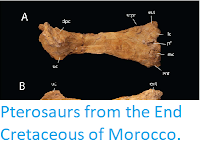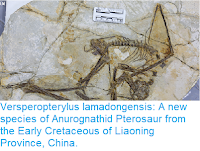Pterosaurs first appeared in the Triassic, survived until the End of the Cretaceous, and were the first vertebrate
group to achieve powered flight, long before the appearance of Birds.
They had membranous wings supported on their elongated fourth digits,
and moved on all fours when on the ground. The Pterosaurs underwent a
major radiation at the beginning of the Jurassic, then a second
radiation at the beginning of the Cretaceous when a more advanced group
of short-tailed Pterosaurs appeared and became dominant. Despite their long history and high diversity, the fossil record of Pterosaurs is somewhat limited, probably due to their lightweight, fragile skeletons, with most known Pterosaur fossils coming from a relatively small number of localities.
In a paper published in the journal Scientific Reports on 20 March 2019, Borja Holgado of the Laboratory of Systematics and Taphonomy of Fossil Vertebrates at the Museu Nacional of the Federal University of Rio de Janeiro, and the Institut Català de Paleontologia Miquel Crusafont at the Universitat Autònoma de Barcelona, Rodrigo Pêgas, also of the Laboratory of Systematics and Taphonomy of Fossil Vertebrates at the Museu Nacional of the Federal University of Rio de Janeiro, José Ignacio Canudo of the Grupo Aragosaurus and Museo de Ciencias Naturales at the Universidad de Zaragoza, Josep Fortuny, also of the Institut Català de Paleontologia Miquel Crusafont at the Universitat Autònoma de Barcelona, Taissa Rodrigues of the Laboratório de Paleontologia at the Universidade Federal do Espírito Santo, Julio Company of the Departamento de Ingeniería del Terreno of the Universidad Politécnica de Valencia, and Alexander Kellner, again of the Laboratory of Systematics and Taphonomy of Fossil Vertebrates at the Museu Nacional of the Federal University of Rio de Janeiro, describe a new species of Pterosaur from the Early Cretaceous Morenillo limestones of the Blesa Formation at Los Quiñones in Teruel Province in Aragón, northeast Spain.
The new species is named Iberodactylus andreui, where 'Iberodactylus' means 'Iberian wing' and 'andreui' honours Javier Andreu, a local collector who found the specimen from which the species is named in the late 1980s. The specimen comprises the anterior portion of a rostrum, including the premaxillae (which has a premaxillary crest) and maxillae, both with alveoli and broken teeth.
Partial rostrum of Iberodactylus andreui. Photographic images (A) – (F) and 3D renderings obtained from μCT data (G) – (L) in right lateral (A), (G), left lateral (B), (H), dorsal (C), (I), palatal (D), (J), caudal (E), (K), and cranial (F), (L) views. Scale bar in cm. Abbreviations. pm: premaxilla; pmcr: premaxillary crest; prid: palatal ridge; te: teeth; trb: trabeculae. Holgado et al. (2019).
The specimen is considered to be extremely similar to the Anhanguerian Pterosaur Hamipterus tianshanensis, from the Early Cretaceous of Xinjiang in northwestern China, to the extent that Holgado et al. create a new family, the Hamipteridae, to unite the two. Based upon this comparison, they further suggest that the specimen came from an animal with a wingspan of between 3.05 and 3.29 m.
Comparison of the rostrum of Iberodactylus andreui with a cast of a skull of Hamipterus tianshanensis. Pictures in right lateral (A), (C) and palatal (B), (D) views. Holgado et al. (2019).
See also...
Follow Sciency Thoughts on Facebook.








